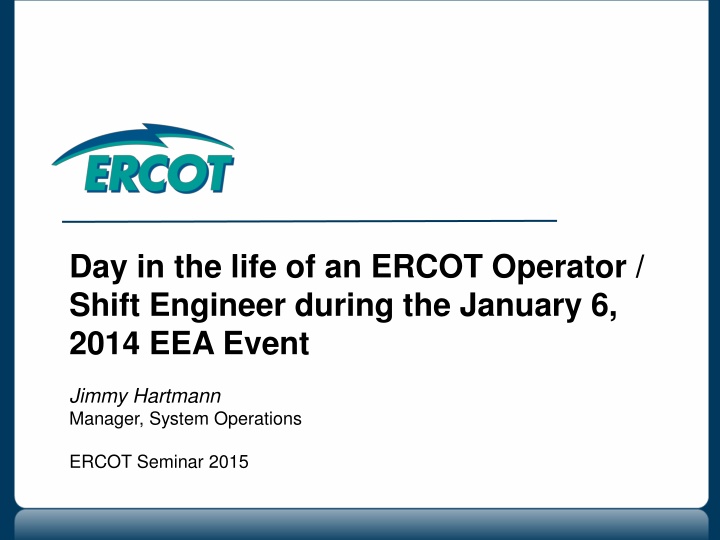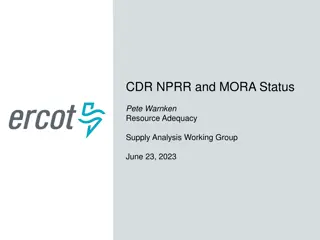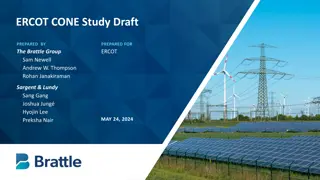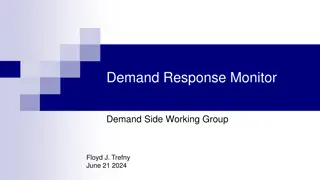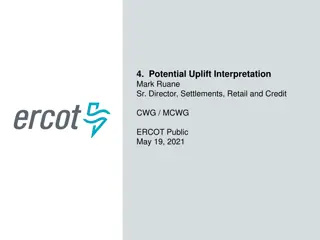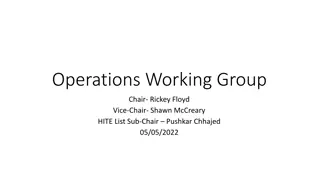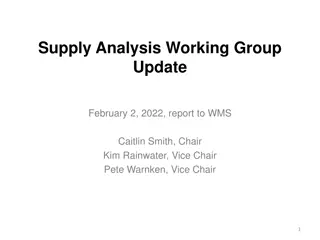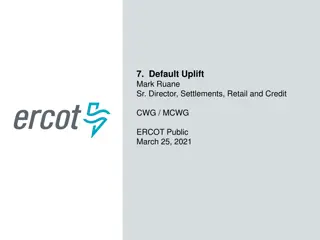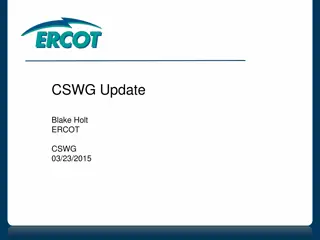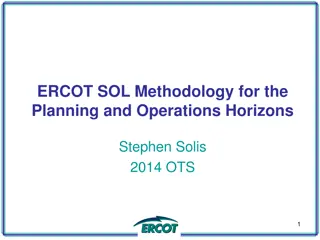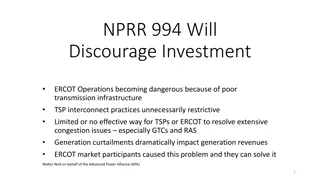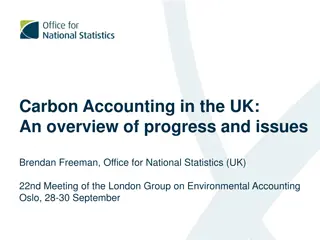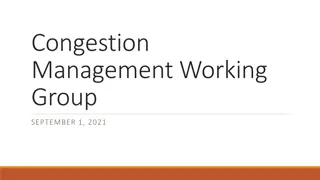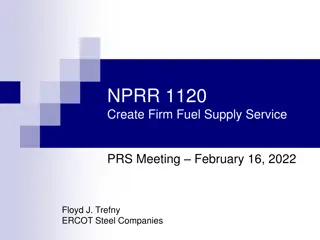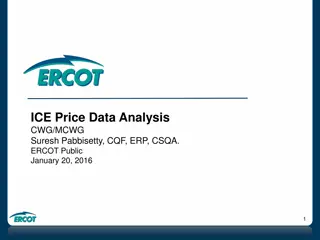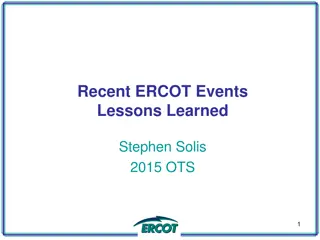A Glimpse into an ERCOT Operator's Role During the January 6, 2014 EEA Event
Amid freezing conditions and generation resource challenges, ERCOT operators responded to an emergency on January 6, 2014, leading to the declaration of Energy Emergency Alerts. This snapshot showcases the critical tasks and decisions made by ERCOT personnel during this event.
Download Presentation

Please find below an Image/Link to download the presentation.
The content on the website is provided AS IS for your information and personal use only. It may not be sold, licensed, or shared on other websites without obtaining consent from the author.If you encounter any issues during the download, it is possible that the publisher has removed the file from their server.
You are allowed to download the files provided on this website for personal or commercial use, subject to the condition that they are used lawfully. All files are the property of their respective owners.
The content on the website is provided AS IS for your information and personal use only. It may not be sold, licensed, or shared on other websites without obtaining consent from the author.
E N D
Presentation Transcript
Day in the life of an ERCOT Operator / Shift Engineer during the January 6, 2014 EEA Event Jimmy Hartmann Manager, System Operations ERCOT Seminar 2015
Introductions Shift Engineer Shift Supervisor Transmission and Security Real-Time DC-Tie Resource RUC 2
Objectives At the completion of this presentation you will: Describe actions taken by ERCOT operators in response to a capacity shortage Explain the current process for TCEQ enforcement discretion during an EEA Describe ERCOT operator desk specific tasks associated with responding to an extreme cold weather event Define the possible Market Notifications issued by ERCOT during an extreme cold weather event Identify where Market Participants can locate the ERCOT operator desk procedures Explain Operator Authority 4
Pre-Event Conditions January 5, 2014, a cold weather front swept across the ERCOT region, bringing with it freezing conditions across much of the interconnection the evening of the 5th and into the 6th. An Advisory for extreme cold weather was issued at 10:00 on January 5th. Extreme cold weather notifications are called when the daily temperatures are forecasted to remain 32 F or below in the following weather zones: North Central (NORTH_C) South Central (SOUTH_C) Coast (COAST) 6
Event Summary The morning of January 6, 2014, ERCOT entered into emergency operations. The unavailability of generation resources due to outages, derates, and failures to start in conjunction with freezing conditions contributed to the event. As the load increased due to the morning ramp and generation resource unavailability continued to increase, reserves declined. At 06:52 ERCOT entered level 1 of its Energy Emergency Alert (EEA) plan. EEA level 2 was declared at 07:01 7
Time-Line of Events At the completion of this presentation you will: Describe actions taken by ERCOT operators in response to a capacity shortage Explain the current process for TCEQ enforcement discretion during an EEA Describe ERCOT operator desk specific tasks associated with responding to an extreme cold weather event Define the possible Market Notifications issued by ERCOT during an extreme cold weather event Identify where Market Participants can locate the ERCOT operator desk procedures Explain Operator Authority 8
Load Forecast Describe actions taken by ERCOT operators in response to a capacity shortage Explain the current process for TCEQ enforcement discretion during an EEA Describe ERCOT operator desk specific tasks associated with responding to an extreme cold weather event Define the possible Market Notifications issued by ERCOT during an extreme cold weather event Identify where Market Participants can locate the ERCOT operator desk procedures Explain Operator Authority 10
RUC Operator Response to a Capacity Shortage RUC Operator Running HRUC Enough generation to cover load forecast and solve transmission congestion. Commit any generation with a unit status of OFF or EMR that can be On-line within the timeframe of the emergency. 11
Real-Time Operator Response to a Capacity Shortage Monitors PRC and makes the Hotline calls to the QSEs Advisory PRC below 3000 MW Watch PRC below 2500 MW EEA 1 PRC below 2300 MW o Deploy ERS ERS-30 and / ERS-30 weather-sensitive (June September, during BH2 or BH3) o HASL Release (HASL-(Gen+ 5 min load ramp) < = 200 MW manually deploy 500 MW of RRS 10 min. < = 200 MW manually deploy another 500 MW PRC < = 2000 MW deploy remaining RRS EEA 2 Maintain 60 Hz or PRC below 1750 MW o Deploy ERS ERS-10 and / ERS-10 weather-sensitive (June September, during BH2 or BH3) o Deploy Load Resources EEA 3 Maintain 59.8 Hz 12
Resource Operator Response to a Capacity Shortage Posts the notifications on the MIS Public for each step Advisory, Watch, EEA 1, EEA 2 & EEA 3 Send the XML deployments for Off-line Non-Spin, ERS-30, ERS- 10, including weather sensitive ERS and Load Resources As Business Hours change, additional services may be deployed 13
DC-Tie Operator Response to a Capacity Shortage 5 DC-Ties East 600 MW North 220 MW Laredo 100 MW Railroad 170 MW South 30 MW Curtail all exports (expect Oklaunion exemption) Request emergency energy if any available capacity on DC-Ties: Southwest Power Pool (SPP) for the East or North DC-Ties. Comision Federal de Electricidad (CFE) through AEP TO for the South DC-Tie and Laredo VFT and Sharyland for the Railroad DC- Tie. 14
Transmission Operators Response to a Capacity Shortage Makes the Hotline calls to the TOs EEA 1 PRC below 2300 MW o Deploy Load Management Program - Only on weekdays (except holidays) during June to September between 1330 and 1900 hours. o Block Load Transfers can be utilized EEA 2 PRC below 1750 MW o Reduce customer loads by using distribution voltage reduction measures, if deemed beneficial EEA 3 Maintain 59.8 o Shed firm load Works with Shift Engineer and coordinating with Local Transmission Operators to determine which actions should be taken for constraints that are limiting generation output (effective 5/1/15) 15
Shift Engineer Response to a Capacity Shortage NPRR 642/NOGRR135 Constraint Management in EEAs (effective 5/1/15) o Evaluate constraints active in SCED, determine which constraints have the potential to limit generation output Restore transmission elements that are out of service Reconfiguring the transmission system Adjustments to phase angle regulator tap positions 15-minute rating available Determine whether double-circuit failures are at a high risk of occurring due to system conditions Send message from Emergency Notification System Start internal event reporting 16
Shift Supervisor Response to a Capacity Shortage Coordinates and makes sure all steps are completed 17
ERCOT Operator Response to a Capacity Shortage Protocol Section 6.5.9.4.2 Operating Guide Section 4.5.3.3 ERCOT Operator Procedures ERCOT.com Grid Information>Operating Procedures Transmission Operators Transmission and Security Operating Procedure QSE s Real Time Operating Procedure 19
Notice of Enforcement Discretion on Air Permitting Market Notice M-C041114-01 was sent out on 4/11/2014 Texas Commission on Environmental Quality (TCEQ) will use its enforcement discretion for power generating facilities when ERCOT is in an EEA situation. Any Generator who will exceed its air permit limits during an EEA should provide notice of this to the Director of Critical Infrastruction Division of TCEQ by e-mail. No response from them is needed. 20
Extreme Cold Weather Extreme cold weather notifications will be issued when temperatures and/or wind chill is expected to be below freezing for sustained periods and may abnormally impact load levels or generation availability. 22
Transmission Operator Extreme Cold Weather Makes the Hotline calls to the TOs Issue an OCN - when approaching extreme cold weather is approximately 5 days away o Review Planned outages and existing outages for the possibility of canceling or restoring equipment o Review and implement winterization procedures o Notify ERCOT of any changes or conditions that could affect reliability Issue an Advisory - when approximately 3 days away Issue a Watch - when approximately 1 day away with concerns that this event could abnormally impact load levels or generation availability Issue an Emergency only if weather is having an adverse impact on the system (EEA or local transmission emergency) 23
Real-Time Operator Extreme Cold Weather Makes the Hotline call to the QSEs Issue an OCN - when approaching extreme cold weather is approximately 5 days away o Review fuel supplies and notify ERCOT of any known or anticipated fuel restrictions o Review Planned Resource outages and consider delaying maintenance or returning form outage early o Review and implement winterization procedures o Notify ERCOT of any changes or conditions that could affect reliability Issue an Advisory - when approximately 3 days away Issue a Watch - when approximately 1 day away with concerns that the event could abnormally impact load levels or generation availability Issue an Emergency only if weather is having an adverse impact on the system (EEA or local transmission emergency) 24
Resource Operator Extreme Cold Weather Determine if additional Ancillary Services are needed for one or more Operating Hours than were procured in the Day-Ahead Guideline for that determination: o Look at Self-Scheduled HSL Margin after DRUC is complete o When wind chill is expected to be below freezing, a minimum of 600 MW is required for those hours, OR o When wind chill is expected to be below 20 F, a minimum of 1300 MW is required for those hours. Issue a Watch to increase the system-wide A/S requirement above what was procured in the Day-Ahead, give the 30 minute notice for QSEs to update A/S Offers 25
Operator Authority NERC Standards: EOP-002-3.1 R1 Each BA and RC shall have the responsibility and clear decision-making authority to take whatever actions are needed to ensure the reliability of its respective area and shall exercise specific authority to alleviate capacity and energy emergencies IRO-001-1.1 R3 The RC shall have clear decision-making authority to act and to direct actions to be taken by TOPs, BA, GOP, TSP, LSE, PSE within its RC area to preserve the integrity and reliability of the BES. These actions shall be take without delay, but no longer than 30 minutes 27
Operator Authority NERC Standards: PER-001-0.2 R1 Each TOP and BA shall provide operating personnel with the responsibility and authority to implement real- time actions to ensure the stable and reliable operation of the BES TOP-001-1a R1 Each TOP shall have the responsibility and clear decision-making authority to take whatever actions are needed to ensure the reliability of its area and shall exercise specific authority to alleviate operating emergencies 28
Operator Authority Protocols 6.5.1.1 ERCOT Control Area Authority Operating Guides 4.5.2 - The ERCOT System Operators have the authority to make and carry through decisions that are required to operate the ERCOT System during emergency or adverse conditions 29
QUESTIONS 30
Question 1 1) Which ERCOT desk Operator is monitoring the PRC? a) ERCOT Shift Engineer b) ERCOT Shift Supervisor c) ERCOT Real-Time Operator d) ERCOT RUC Operator 31
Question 2 2) Identify the current procedure for TCEQ enforcement discretion during an EEA event: a) Call ERCOT Shift Supervisor b) Call ERCOT Account Manager c) Send e-mail to TCEQ d) Send e-mail to ERCOT CEO 32
Question 3 3) Identify which action TO s and QSE s should prepare for an extreme cold weather event: a) Call in sick during the event b) Review and implement weatherization and emergency operating procedures c) No action needed d) Ask the Texas Regional Entity 33
Question 4 4) What Market Notifications could be issued by ERCOT in preparation for an extreme cold weather event? a) OCN, Advisory, or Watch b) Market Bulletin c) News release d) E-mail from ERCOT CEO 34
Question 5 5) Identify where Market Participants can locate the ERCOT operator desk procedures a) Protocols b) Operating Guides c) NERC Standards d) ERCOT.com 35
Question 6 6) Identify Operator Authority: a) Responsibility and authority to implement real- time actions to ensure the stable and reliable operation of the BES b) Responsible for saying who can come into the control room c) Authority to operate transmission equipment d) Don t have to listen to my Manager 36
Questions 37
